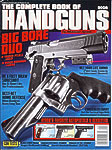
PAIR OF KAHR 9MMS
Steel or plastic — MK9 or PM9 — concealed carry perfection!
Complete Book of Handguns 2008, p. 44 - 49
By Massad Ayoob
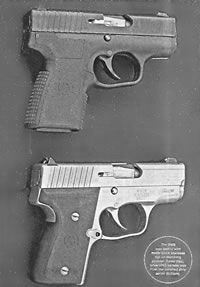
The PM9 was tested with matte black stainless top on matching polymer frame (top), while MK9 sample was from the polished Elite series (bottom).

The MK9 (silver colored, top) slightly out-shot the PM9 (all-black, bottom) in 25-yard accuracy testing.
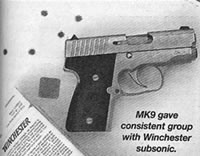
MK9 gave consistent group with Winchester subsonic.
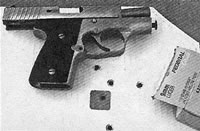
The 4+1 syndrome was less pronounced, and grouping tighter with this MK9 and Federal ammo as compared to polymer version of same gun.
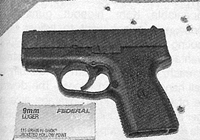
The 4+1 syndrome. Errant shot down by rear of grip was first hand-chambered round fired from PM9 in this string of fire.
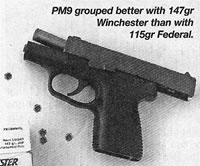
PM9 grouped better with 147gr Winchester than with 115gr Federal.
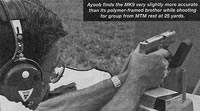
Ayoob finds the MK9 very slightly more accurate than its polymer-framed brother while shooting for group from MTM rest at 25 yards.
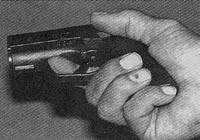
High thumb shooting grasp provides an ample trigger reach on the small frame with the little finger tucked under the butt.
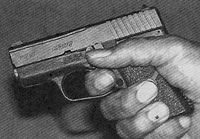
With thumb pointed straight to target, trigger finger is not impeded and thumb is clear of slide stop. This is author's preferred right-hand-only grasp of Kahr.
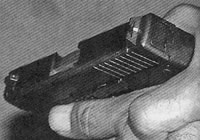
Author's preferred two-hand grasp of Kahr is this modified Leatham-Enos hold. Firing thumb is completely clear of pistol and on support hand.
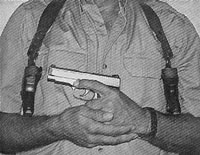
Of course, you can skip the decision and carry one of each in twin shoulder holsters like these by Mitch Rosen, with a longer-slide Kahr T9 for practice.
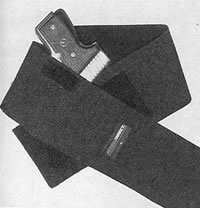
Lady mentioned in article wears MK9 to work daily in a belly-band like this one from Action Direct.
We live in a time when, as our groceries are about to be bagged at the supermarket, we might be asked, “Would you like paper or plastic?”
We also live in a time when if we walk into a gun shop and say, “I'd like to see one of those really small 9mm Kahr pistols,” the professional behind the counter might well reply, “Would you like to see that in steel or plastic?”
Introduced decades ago by Heckler&Koch for their relatively short-lived P9S and VP70Z pistols, and hugely popularized in the early 1980s by Glock, semiautomatic pistol frames made of polymer are here to stay. One company, which understood it was “easier to join 'em than to beat 'em,” is Kahr Arms, which has been hugely successful in supplementing its steel-frame pistols with functionally identical models that utilize polymer frames.
Most companies that offer both types of handgun construction do it primarily with different models. Smith&Wesson's polymer-framed Military&Police, SW99, and Sigma handguns have been dramatically different in design from their metal-frame autopistols both in all-metal frames and in polymer, but the two lines differ markedly. Beretta has made a “plastic-framed version” of its Models 92 and 96, but hedged their bets by putting more emphasis on a new design, the Px4, which was built around a polymer receiver from its first conception on the drawing board.
Kahr, on the other hand, started with good, functional designs, double-action-only, striker-fired autopistols in various size formats, and fitted the top ends to polymer frames. This gives us the opportunity to do a much more direct comparison between the frame types, since the “guts” of the pistols, and the top ends, are for all practical purposes the same between the two.
Gun Details
For the comparison we chose the Micro-size Kahrs, the smallest of their kind. Both are chambered for the 9mm. Both will carry six rounds in their short, flat bottom magazines, one more in the firing chamber, and another seven in a longer spare magazine with a finger extension that comes with each gun.
Each has a 3-inch barrel. Each has essentially, identical function. Each comes with von Stavenhagen pattern (“dot the i”) fixed sights, and each can be had at additional cost with tritium night sights. They use the same magazines. The MK9 is made of all stainless steel, including the frame, and comes with Hogue grips that bear the Kahr logo. The PM9 has a polymer frame.
There are points in favor of each format. Let's take a look at them, issue by issue.
Aesthetics: Tie. “There's no accounting for taste,” “one man's meat is another man's poison,” and all of that. Both models have been offered in matte black, and the PM is offered with stainless slide on flat black (actually, dark gray) frame, while the MK9 is most often seen in matte stainless. The MK is also available in a more polished version known as the Elite. Aesthetics is all about looks. Looks are subjective, and it's up to you.
Weight: Favors PM9. Unloaded, the little plastic pistol is built to tip the scales at 14 ounces. In all-steel construction the MK9 is about half again heavier, its factory spec is 22 ounces unloaded. Of course, there are .380s out there that are bigger and heavier than either.
Shootability: Favors MK9. This is the flip side of the PM9's weight advantage, more weight means less recoil. There is palpably more jump in the lighter pistol. However, it is not a painful increase in recoil. Personally, I don't notice the difference until I get to about 15 yards, shooting 6-inch steel plates on a dueling tree. There, the electronic timer tells me, it's taking me a bit longer to hit the six disks with the lighter pistol. However, recoil is subjective, and it affects some more than others. Still, objectively and tangibly, the all-steel Kahr moves less in reaction to firing than does the plastic-framed Kahr, using the same ammunition.
Cost: Favors PM9. The PM series stars at a manufacture's suggested retail price of $749. The beginning MSRP for the MK series is $792. That gives the PM9 a $43 price advantage, due primarily to the factory's cost saving in utilizing the polymer frame.
Accuracy: Favors MK9, at least in this particular test. Since they first came out, Kahrs have been notably accurate pistols. The best group I can recall shooting with a Micro-size Kahr went around 2.25 inches and 2.50 inches at 25 yards with the excellent +P Tactical 9mm load that John Kopel used to manufacture under the Pro-Load name. That happened to have been shot with a polymer frame PM9.
However, in this go-around, the all-steel Kahr was visibly more accurate off the bench than the one with the polymer frame. Each was shot with two loads, both of which have a history of being very accurate 9mm loads in general, and in Kahr pistols in particular.
Winchester's 147-grain subsonic copper jacketed hollow point was initially developed more for accuracy than expansion, and in its first iteration was actually named Olin Super Match (OSM). From the petite polymer pistol, it put five shots into 3.35 inches, which is respectable for a pistol of this size, weight and horsepower. The best three shots were in 1.25 inches.
However, the same Winchester subsonic beat that group by 0.65 of an inch out of the solid steel shooter, punching five holes that measured 2.70 inches apart, farthest-to-farthest and center-to-center. “Best three” went 1.55 inches, a little looser than its polymer sibling.
Next up was another 9mm load famed for its accuracy, Federal 9BP. Like the Winchester OSM, it's a conventional jacketed hollow-point-design, but it weighs 115 grains. Federal carries it in their mainstream “classic” line. The group measured 2.85 inches for all five shots out of the all-stainless MK9, with a “best three” that went 1.45 inches. Out of the polymer-framed PM9, the total group size was a comparatively disappointing 4.85 inches, and 2.25 inches for the best three hits.
One thing I notice was that every group had an “outrider” shot that was separate from the others. Most of the time, this was the very first shot. I've noticed over the years that most Kahr pistols exhibit some “4-plus-1 syndrome,” which is, the first hand-chambered cartridge sends its bullet to a subtly different point of impact vis-à-vis point of aim than it sends subsequent, mechanically cycled rounds. To allow for this, I took the time to factor out the worst shot from each 25-yard group, and in effect measure the best four shots in each sequence.
Those four shot measurements came out like this, with all measurements taken to the nearest 0.05 of an inch. PM9/Winchester 147-grain: 1.65 inches. PM9/Federal 115-grain: 3.30 inches. MK9/Wincheter 147-grain: 2.45 inches. MK9/Federal 115-grain: 2.05 inches.
That brought things closer. Taking the worst (usually first-fired) hit out of the equation, the polymer PM9 averaged 2.48 inches, and the all-steel MK9 averaged 2.25 inches. This showed that of these two examples, the polymer gun was definitely suffering from 4-plus-1 syndrome more acutely than the steel gun. Still, the MK9 won the accuracy test. And, in the real world, the first shot is the one that counts the most, so I'm comfortable giving that round of the fight to the MK9 in this particular match-up.
Looking at the five areas discussed, I can say objectively that the PM9 wins in two areas, cost and weight. I can say with equal objectivity that, at least between these two pistols, the MK9 also wins in two areas, shootability and accuracy. They tie on the subjective area of aesthetics.
But now, confusingly, the potential buyer has to weigh those objective characteristics against their subjective needs. Exactly how much does the weight difference mean to her? Exactly how much does the accuracy difference mean to him?
Cost may be a critical issue for Buyer A but inconsequential to Buyer B.
Meet A Two-Kahr Family
Let me introduce you to a couple in their 50s who both own and carry Kahr subcompact 9mm pistols. After shooting both and carrying both, one picked one model and the other picked the other.
The wife works in the medical field and spends most of her day in a “gun-free zone,” a hospital in a good-size city. She finds it convenient to commute to and from work wearing her “duty uniform,” loose-fitting scrubs. She has to discreetly don and doff her carry gun in the parking lot at work, leaving it under lock and key there while she's making her living. She wanted a flat, compact 9mm that would be comfortable and totally concealable in a quick-on, quick-off elastic bellyband that secures with Velcro.
The husband is self-employed, and on most work days can dress as he pleases, but his job dictates that he occasionally show up someplace wearing a tailored suit. The suit jacket may come off in the course of his workday and it is imperative that it not be revealed that he is armed when this happens. He is also partial to a bellyband. He's comfortable with a good 9mm pistol with a street-proven hollow-point load.
The wife chose the MK9 pistol. “The weight difference didn't matter to me as much as I thought it would, once I tried both in the bellyband,” she explains. “There's 4 inches of elastic there, and it secures the gun so well, I can barely tell the difference. When I'm shooting them, though, there's a big difference. You guys have thicker wrists, and I don't think recoil bothers you as much as it does us. I'm faster, more accurate, and more confident with the MK9. Right now, there's nothing that suits me better for going to and from work.”
The husband also tried both guns, and says, “I wind up with the PM9 most of the time when I need deep concealment carry. She very seldom carries in a pocket, and never wears an ankle holster, but I've used both those types of carry. Hanging at the end of your leg, you definitely appreciate the polymer frame taking almost half a pound off the weight, and you notice it a lot in the pocket too, especially when you're wearing suit pants made of tropical fabric instead of, say, jeans or cargo pants. I have to agree with her that I don't see much difference when you carry it inside the waistband. The Hogue grips that feel so good when you're shooting the MK9 get a bit tacky against fabric, and it slows down getting the gun up and out. The ‘polymer’s sides of the frame on the PM9 don't do that, and they're just a tiny bit thinner, too. With that particular carry rig, I can get the PM9 out a bit faster than I can the MK9. And with a close-range self-defense gun, I don't worry two much about an inch here or there at 25 yards. In close, I don't think the recoil difference is going to matter much, either.”
The fact is that we tailor the tools to the task. That includes the type of holster, the size of our hand, the wardrobe in which we'll be carrying the pistol. Husband and wife both carry somewhat larger pistols when they're on their own time and can dress around the guns. For each of them, the Micro Kahr 9mm is a special-purpose handgun tailored to situations where discretion and undetected carry are paramount, and some other elements take a back seat to those needs.
Both are happy with the total reliability of their Kahr pistols, polymer frame or steel. They carry them loaded with Winchester Ranger 127-grain +P+ hollow point. Both guns handle the hot loads without skipping a beat.
Final Notes
Whichever of these deliciously flat and concealable Kahr hideout guns you choose, you might want to adjust your shooting technique to suit the guns. One advantage of the Kahrs is a very short trigger reach, which suits them wonderfully to small hands and short fingers. The downside of that is that in an average size or larger male hand, if the firing hand's thumb curls down on the grip, the pull stroke is so short-reach that the trigger finger may actually hit the thumb and stop trigger movement before the pistol can fire.
A high thumb grip is one cure for that, but if you're firing right-handed, it puts the right thumb in proximity to my pet peeve about Kahr pistols, the nasty sharp edges of the slide stop lever. The damn things can draw blood in an extended shooting session. Manufacture's Notes: Kahr has recently reconfigured their slide stop levers to eliminate this “pet peeve” of Mr. Ayoob.
The best bet seems to be to aim the thumb straight at the target. If it stays below the slide stop, it won't knock that lever upward and accidentally jam the gun open during a string of fire, and now the trigger finger has a clear path through which to do its job. In a two-hand grasp with the Kahr, I find myself using the Leatham-Enos competition grip, where the thumb of the firing hand actually rests on the back of the support hand, making no contact with the pistol at all. Because I use a firm grasp, I find myself pressing down into the support hand with the firing thumb, but that doesn't seem to hurt anything.
The short grip-frame that helps make all the Micro Kahrs so wonderfully adaptable to deep concealed carry leaves no place for the pinkie finger. I just tuck mine under the butt. Works fine there.
If you are getting a sense of the author waffling as to choice, you're absolutely right. I always try to avoid that old gun-writer cop-out, “They're all wonderful! Just pick the one that fits your hand best!” Here, it's a little more complicated than that. The PM9's much lighter weight and obviously lower cost must be balanced against not only the MK9's slightly superior “shootability,” but against the individual shooter's particular need, wardrobe, etc.
I can say that I'm personally happy with both. Your local dealer can show you each. And when you make your decision and reach for your wallet, you'll finally be the one who gets to say, “Do you prefer paper or plastic?”
<< Go back to Previous Page